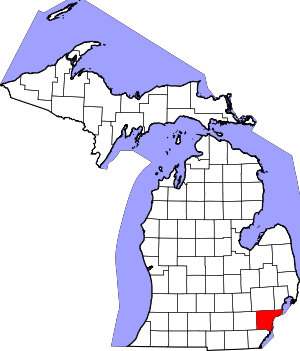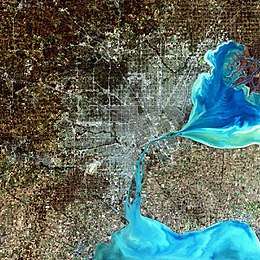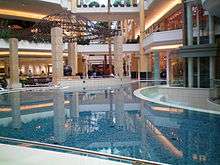Wyandotte, Michigan
Wyandotte (/ˈwaɪənˌdɒt/) is a city in Wayne County in the U.S. state of Michigan. The population was 25,883 at the 2010 census,[6] a decrease of 7.6% from 2000. Wyandotte is located in southeastern Michigan, approximately 11 miles (18 km) south of Detroit on the Detroit River, and is part of the collection of communities known as Downriver. Wyandotte is bounded by Southgate (west), Lincoln Park (northwest), Riverview (south), Ecorse (north) and Lasalle (east).
Wyandotte, Michigan | |
|---|---|
| City of Wyandotte | |
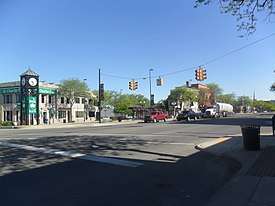 Looking north at Downtown Wyandotte at Biddle Avenue | |
 Location within Wayne County | |
 Wyandotte Location within the state of Michigan | |
| Coordinates: 42°12′31″N 83°09′45″W | |
| Country | |
| State | |
| County | |
| Founded | 1854 |
| Incorporated | 1867 |
| Government | |
| • Type | Mayor–council |
| • Mayor | Robert A. DeSana |
| • Mayor pro tem | Robert A. DeSana |
| Area | |
| • City | 6.98 sq mi (18.08 km2) |
| • Land | 5.29 sq mi (13.71 km2) |
| • Water | 1.69 sq mi (4.37 km2) |
| Elevation | 581 ft (177 m) |
| Population | |
| • City | 25,883 |
| • Estimate (2019)[3] | 24,859 |
| • Density | 4,697.47/sq mi (1,813.61/km2) |
| • Metro | 4,285,832 (Metro Detroit) |
| Time zone | UTC-5 (EST) |
| • Summer (DST) | UTC-4 (EDT) |
| ZIP code(s) | 48192 |
| Area code(s) | 734 |
| FIPS code | 26-88900[4] |
| GNIS feature ID | 1616849[5] |
| Website | Official website |
Wyandotte is a sister city to Komaki, Japan, and each year delegates from Komaki come to Wyandotte to tour the city.
History
Founded as a village in 1854 (deeded by John Biddle to Eber Ward, et al. on December 12, 1854), Wyandotte was incorporated as a city, and granted a charter by the State of Michigan, on December 12, 1866, with the first city election held in April 1867, thus making it the oldest incorporated city in Wayne County other than Detroit. The site where Wyandotte sits today in the 18th century was a small village called by the native Indians "Maquaqua" and by the local French "Monguagon". This Native American tribe was known as the Wyandot or Wendat, and were part of the Huron nation originally from the Georgian Bay area of Canada.
It was from near here, along the banks of Ecorse Creek, now a northern boundary of the present-day city, that Chief Pontiac plotted his failed attack against the British garrisoned Fort of Detroit, in 1763. The center of the village was nearly parallel to Biddle Avenue between Oak Street and Eureka Road near the river and its sandy beach, which was a welcome feature to the local tribesmen, as their main mode of transportation to the fort in Detroit was by birch bark canoe. The tribe was considered peaceable and friendly with the British, the remaining French in the area, and the newly arrived Americans.
They were a farming tribe and were therefore fairly stable in their settlement, relying heavily on hunting in the local surrounding hardwood forest, fishing from the river, and trading with the nearby fort and associated settlers to supplement their existence. Between Maquaqua/Wyandotte and Detroit (a distance of roughly 10 to 12 miles (16 to 19 km)) there were numerous settlers living along the river who inhabited their ancient "Ribbon Farms", some dating back to the time of Antoine Cadillac's founding of "Fort Pontchartrain du Détroit", in July 1701.
In 1818, the Wyandot signed a treaty with the U.S. government relinquishing this land, some moving to an area near Flat Rock, Michigan, then to Ohio, Kansas and finally Oklahoma; however, most of the Native Americans who lived in what is now Wyandotte, moved across the Detroit River to Anderdon, Windsor, Ontario, where their descendants live still today. The name somewhat lives on as Wyandotte County, Kansas.[7]
One of the first white settlers to come to Wyandotte in the years after the Native Americans left was John Biddle, a Pennsylvania-born former Army major who fought in the War of 1812 and later went on to a prolific political career, serving as mayor of Detroit, delegate from the Territory of Michigan in the U.S. Congress, president of the Michigan Central Railroad, member and later speaker of the Michigan House of Representatives and one-time candidate for Michigan Governor.[8] West Jefferson Avenue, which begins in downtown Detroit and runs south to Berlin Township, becomes Biddle Avenue within Wyandotte city limits.
Biddle purchased a 2,200-acre (8.9 km2) plot near modern Biddle Avenue and Vinewood Avenue in 1835 and created a farm he called "The Wyandotte." He sold the plot in 1854 to Eber Ward of the Eureka Iron Company for $44,000. In 1864, Captain Eber Brock Ward used a high-quality grade of iron ore (known as "Superior") from the recently opened Marquette Range in the Upper Peninsula, and smelted it into the first Bessemer Steel commercially cast in America, using the patented Bessemer process.[9] In 1865, the process created steel rails and allowed an explosion of iron-related businesses to open in the region. As a result, Detroit soon became a major center of iron production, especially for use in stoves. (Wyandotte was home to several companies as well, including the Regeant Stove Co.) It would be this technology that would give Henry Ford from nearby Dearborn the capabilities to create large amounts of steel for his automobile assembly lines.
John S. Van Alstyne, general manager for Eber Ward of both the Eureka Iron & Steel Works and the associated Wyandotte Rolling Mills, laid out the master plan for the city. This plan was frequently called the "Philadelphia Plan", with streets laid out on a north–south and east–west grid. Streets running in the east–west direction were named after native plants and trees; the streets running north–south were simply numbered, increasing in value from the river westward. Van Alstyne was elected as the city's first mayor in 1867. A street along Wyandotte's Detroit River is named after him – on the site of the former iron works he managed, after it failed and was razed around 1904.
He would also go on to found the Wyandotte Savings Bank in 1871, which was housed in the main office building of the Eureka Iron Works (which still stands at the southwest corner of Biddle and Elm; though greatly remodeled, it remains the oldest building in the city today) for decades until it relocated into a new building at the northwest corner of Biddle and Eureka Road in 1981, where it remained until it was acquired in January 1989 by NBD Bancorp. After 1995, successors to NBD – First National Bank of Chicago, Bank One, and Chase Bank – continued to operate in the same building, sharing it with the Wyandotte City Hall, which relocated into that building from a nearby former department store building in late 2012, until closing this branch in 2019.
Eureka Iron Works prospered through the late 19th century but suffered a shortage of raw materials. It closed in 1892, but not before Wyandotte became a major hub in the chemical production industry, possible because of the many salt mines deep below the city.
A community named New Jerusalem consisting of immigrants from multiple nations was founded in the 1890s in what is now Wyandotte. It was incorporated as a village with the name of Glenwood in 1900. In 1901 a post office was established here with the name of Bacon since there was already a Glenwood post office in Wayne Township, Cass County, Michigan. Wyandotte annexed the community in 1905.[10]
The community of Ford City was founded as a village in 1902. It was named for John B. Ford who ran the Michigan Alkali Company there. In 1922 it merged with Wyandotte.[11]
Business and industry
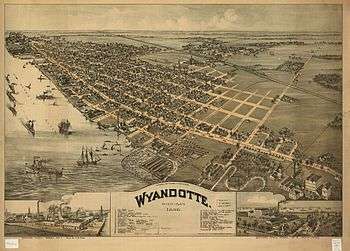
An early figure was Captain John Baptiste Ford, who used the salt to create soda ash, which in turn was used to create plate glass. In 1893, he created Michigan Alkali Company, which created baking soda, soda ash and lye. The company, later renamed Wyandotte Chemicals Co., went on to create a variety of soaps and cleaners, eventually becoming part of BASF and expanding into the BASF industrial complex.
Ward also help create Wyandotte's shipbuilding role, which existed from the 1870s into the 1920s. During that time, a wide variety of boats were created along Wyandotte's riverbank, from steamers and tugs to huge ferries. In 1873, Ward's Wyandotte Iron Ship Building Works built the nation's earliest steel-hulled vessel, a tugboat called the Sport.[9] This shipbuilding industry was immortalized in 1942 in the painting of several murals which still exist today in the auditorium of Theodore Roosevelt High School.
Beginning in the 1920s Wyandotte was a major source of toy production, with the All Metal Products Company founded in 1920 and located in Wyandotte on Sycamore Street between 14th and 15th streets. From the 1920s until the 1950s the company, under the name "Wyandotte Toys", was the largest manufacturer of toy guns and pistols in the US, producing a wide variety of pop guns, clicker pistols, dart guns, cap guns and a variety of plastic pistols. The company also produced a wide range of toy airplanes and other vehicles by pressing scrap metal obtained from local automobile factories. The company's motto was "Wyandotte Toys Are Good and Safe." In the early 1950s the company moved to Ohio, and it was bought out by Louis Marx and Company three years later.[12]
Bishop Park, located on the riverfront north of downtown, once had a dock to board the Boblo Boat ferry to Boblo Island.
Today, much of the remaining industry is minor, with a notable exception being BASF Wyandotte on the city's north riverfront.
In July 2002, three workers at an Atofina plant in neighboring Riverview were killed when a rail car leaked a colorless gas called methyl mercaptan. The gas exploded into flames and led to the emergency evacuation of 3,100 area residents, including some Wyandotte citizens.
The city is served by three newspapers: the regional Detroit Free Press and The Detroit News; as well as The News-Herald, which is a more local paper serving the Downriver communities and has roots tracing back to two former newspapers that were published in Wyandotte. Wyandotte is also in the Detroit radio and television markets.
Government and municipal services
Robert DeSana is the current acting Mayor of Wyandotte. A City Council and other elected officials oversee the community's governance. Wyandotte has its own community owned municipal services, called Wyandotte Municipal Services, it provides its own power through a municipal power plant and operates city-owned water and cable television services.
The Wyandotte Police Department, like that of its fellow Downriver community Woodhaven, has a Police Explorers post for youths ages 14–21 that have an interest in law enforcement.
Wyandotte's community is served by the Bacon Memorial District Library, a member of the tri-county library system The Library Network. Built out of the Ford-Bacon House on Vinewood Street, it replaced the Wyandotte Carnegie Library in 1942; following the death of Congressman Mark R. Bacon, his widow Mary Ford-Bacon deeded the building to the city. The staff offer guided tours through the historic part of the building.[13]
Education
Primary and secondary schools
Public schools
Wyandotte Public Schools operates the city's public schools. Since 1901, all schools are named for former US presidents.
- Elementary and middle schools include:
- Garfield Elementary School, built in 1932
- James Monroe Elementary School, built in 1954
- George Washington Elementary School, built in the 1930s
- Thomas Jefferson Elementary School, built in 1950
- Middle schools include:
- Woodrow Wilson Middle School, built in 1956
Wyandotte's public high school is Theodore Roosevelt High School, began in 1921 and completed in 1923 and has since expanded four times.
Catholic schools
Currently there are no Catholic schools open in Wyandotte.[14] These are the schools that were formerly open: Our Lady of Mount Carmel Elementary and High School, St. Stanislaus Kostka Elementary School, St. Patrick Elementary and High School, St, Elizabeth Elementary School, St. Joseph Elementary School, and St. Helena Elementary School; also, Wyandotte Catholic Consolidated School (After the consolidation of Sts. Elizabeth, Patirck, and Joseph) were previously in the community. They were a part of the Roman Catholic Archdiocese of Detroit.[15]
Wyandotte Consolidated formed in 1970 from the merger of St. Elizabeth, St. Joseph, and St. Patrick Schools. It closed in 2011 after a downturn in the economy.[16]
Historic sites
Our Lady of Mount Carmel Catholic Church, renamed Our Lady of the Scapular Parish in late 2013, is a Roman Catholic church built in the Polish Cathedral style known for its Old World opulence. It was founded in 1899 by Polish immigrants.
Sports and recreation
The city is home to the Wyandotte Boat Club, a rowing facility. The club host to three local regattas: two spring high school regattas and one fall club regatta. The new facility features two indoor rowing tanks, numerous shell racks and shells, erg and weight rooms, men's and women's locker rooms, meeting room, and a massive club/bar over looking the Detroit River. The tanks are used by all of the rowing programs for technique and style training. They have been shown to be of great benefit in the training of novice rowers. During the off season, the tanks are rented by the hour to outside schools and universities. The city has 23 parks in total with the largest being Bishop Park. Pets, bikes and alcohol are prohibited in all Wyandotte city parks. Rollerblades and skateboards are prohibited in all areas except the Wyandotte Skate Park.
F.O.P. Park
Located at the corner of Bondie and 8th Streets, the F.O.P. Park has a large shaded playground and covered pavilion for picnicking. Sports facilities include a basketball court, baseball diamond and two horseshoe pits.[17] The Park has a 66% satisfaction rating out of 45 people surveyed.[18]
F.O.P. Park holds youth baseball and softball games during day and night for the Wyandotte Braves Association. Restroom facilities that are opened during baseball games and other special events.[19]
Kiwanis Park
Kiwanis Park is named in honour of the Kiwanis Club of Wyandotte, which is the town's oldest civic non-profit organization. The Kiwanis Club continues to make an annual contribution to the upkeep of the Park.[20] The Park is located at the intersection of 6th Street and North Drive, and has no restroom facilities.
Lions Club Park
The Lions Club Park is located at the intersection of Vinewood and 9th Avenue next to Our Lady of the Scapular Religious Education Office. It was first opened in August 12, 2009 by the Lions Club. The park is completely enclosed with fences and has benches situated all around it. There is a large playscape and climbing terrace. The hours are 6:00 am to 10:00 pm, year round.
Oak Club Park
The Oak Club Park is at the corner of 20th Street and Vinewood. It has a large shaded area, a playground and basketball court. A small picnic area, water fountain and pavilion are located in the park, which is open from 6am to 10pm year round.[17]
Pulaski Park
Pulaski Park is at the corner of 12 Street and Oxford Court. It hosts multiple softball and baseball fields, two basketball courts, and four tennis courts. Hours are 6:00 am to 10:00 pm, year round.[17]
The Park is named in honour of Count Casimir Pulaski, a statue of whom was dedicated in the park in 1938.[21]
V.F.W Playfield
V.F.W Playfield is a moderate sized park located at the corner of 11th and Cherry. It has a baseball diamond, a very large open field, swings, and a playscape. There is also a covered pavilion. It is located next to Silver Lining Tire Recycling. The hours are 6:00 am to 10:00 pm, year round. Pets, bikes, skateboards and rollerblades are not permitted in the park. Alcohol is not permitted in the park. It is owned by the Veterans Of Foreign Wars, (V.F.W), in Wyandotte.[22]
WAA Park
A smaller park located on Highland and Alfred street in the north end of Wyandotte, it has a playground and swing sets, an open play space for sports and other activities. There is a covered pavilion and benches and a sand pit. It is owned by the Wyandotte Athletic Association. The hours are 6:00 am to 10:00 pm, year round.
Transportation
Public transportation
Three Suburban Mobility Authority for Regional Transportation bus routes pass through the city of Wyandotte, providing service seven days a week.
Street grid
Most north–south streets are numbered, starting with 1st Street on the East Side and ending with 23rd Street on the West Side. Most east–west streets south of Northline/Ford Avenue are named after trees such as Walnut, Oak, and Cherry, starting with Spruce Street on the north and ending with Grove Street on the south. South of Grove, the east–west streets are named after Michigan cities, with the east–west Hillsdale, Marshall, Vassar, Ludington, Negaunee and St. Ignace streets, as well as the north–south Albion Street, which is located between 5th and 6th Streets in the far southeast side.
The city has an East Side and a West Side, both unofficial, separated by the aforementioned railroad lines. Most of the numbered streets are one way at some point, most often forming pairs, such as 6th Street with Lindbergh Street between Ford Avenue and Goddard Road, and 22nd and 23rd Streets between Eureka Road and Orchard Street. Electric Street, so called because of the former Detroit United Railway interurban line that ran next to it which connected Detroit and Toledo, is a continuation of a street that starts in southwest Detroit and continues into Riverview.
Most of Wyandotte's western city limits runs along M-85 (Fort Street). It lies in what would've been the location of a 24th Street since it is a block west of 23rd Street, but it is never referred to as "24th Street".
Geography
According to the United States Census Bureau, the city has a total area of 7.01 square miles (18.16 km2), of which 5.27 square miles (13.65 km2) is land and 1.74 square miles (4.51 km2) is water.[23]
The city is 10 miles (16 km) southwest of Downtown Detroit.[24]
Demographics
| Historical population | |||
|---|---|---|---|
| Census | Pop. | %± | |
| 1870 | 2,731 | — | |
| 1880 | 3,631 | 33.0% | |
| 1890 | 3,817 | 5.1% | |
| 1900 | 5,183 | 35.8% | |
| 1910 | 8,287 | 59.9% | |
| 1920 | 13,851 | 67.1% | |
| 1930 | 28,368 | 104.8% | |
| 1940 | 30,618 | 7.9% | |
| 1950 | 36,846 | 20.3% | |
| 1960 | 43,519 | 18.1% | |
| 1970 | 41,061 | −5.6% | |
| 1980 | 34,006 | −17.2% | |
| 1990 | 30,938 | −9.0% | |
| 2000 | 28,006 | −9.5% | |
| 2010 | 25,883 | −7.6% | |
| Est. 2019 | 24,859 | [3] | −4.0% |
| U.S. Decennial Census[25] | |||
2010 census
As of the census[2] of 2010, there were 25,883 people, 10,991 households, and 6,727 families residing in the city. The population density was 4,911.4 inhabitants per square mile (1,896.3/km2). There were 12,081 housing units at an average density of 2,292.4 per square mile (885.1/km2). The racial makeup of the city was 94.7% White, 1.3% African American, 0.7% Native American, 0.5% Asian, 0.9% from other races, and 1.9% from two or more races. Hispanic or Latino of any race were 5.1% of the population.
There were 10,991 households, of which 28.4% had children under the age of 18 living with them, 42.6% were married couples living together, 13.2% had a female householder with no husband present, 5.4% had a male householder with no wife present, and 38.8% were non-families. 33.0% of all households were made up of individuals, and 12.8% had someone living alone who was 65 years of age or older. The average household size was 2.35 and the average family size was 2.99.
The median age in the city was 40.4 years. 21.4% of residents were under the age of 18; 8.5% were between the ages of 18 and 24; 26.4% were from 25 to 44; 29.9% were from 45 to 64; and 13.8% were 65 years of age or older. The gender makeup of the city was 48.9% male and 51.1% female.
2000 census
As of the census[4] of 2000, there were 28,006 people, 11,816 households, and 7,420 families residing in the city. The population density was 5,278.1 per square mile (2,036.4/km2). There were 12,303 housing units at an average density of 2,318.7 per square mile (894.6/km2). The racial makeup of the city was 96.32% White, 0.52% African American, 0.49% Native American, 0.33% Asian, 0.03% Pacific Islander, 0.72% from other races, and 1.59% from two or more races. Hispanic or Latino of any race were 2.91% of the population. Residents are predominantly of Polish descent.
There were 11,816 households, out of which 27.7% had children under the age of 18 living with them, 46.3% were married couples living together, 11.9% had a female householder with no husband present, and 37.2% were non-families. 31.9% of all households were made up of individuals, and 13.3% had someone living alone who was 65 years of age or older. The average household size was 2.36 and the average family size was 2.99.
In the city, the population was spread out, with 22.6% under the age of 18, 8.3% from 18 to 24, 31.6% from 25 to 44, 21.7% from 45 to 64, and 15.7% who were 65 years of age or older. The median age was 38 years. For every 100 females, there were 96.0 males. For every 100 females age 18 and over, there were 93.5 males.
Ancestries (2000): Polish (22.5%), German (21.9%), Irish (17.5%), English (9.0%), French (8.5%), Italian (8.4%).
The median income for a household in the city was $43,740, and the median income for a family was $54,106. Males had a median income of $42,469 versus $27,261 for females. The per capita income for the city was $22,185. About 4.7% of families and 6.2% of the population were below the poverty line, including 8.7% of those under age 18 and 4.0% of those age 65 or over.
Religion
The population of Wyandotte is predominately Roman Catholic.
Among the city's Roman Catholic churches are: Our Lady of Mount Carmel (now the parish of Our Lady of the Scapular), and St. Joseph and St. Patrick (combined into the parish of St. Vincent Pallotti). The status of the church of St. Stanislaus Kostka (which was ordered closed after being combined with Mt. Carmel as Our Lady of the Scapular) is under review in Rome.
Notable people
- Amy Faye Hayes, ring announcer and model.
- Lucille Ball, actress who was raised in the city as a child[26]
- Joe Carollo, tackle for Notre Dame and NFL's Los Angeles Rams
- Dick Dean, born Richard Dean Sawitskas, automobile designer and builder of custom cars
- Aaron Diaz, science popularizer and creator of the comic Dresden Codak
- Gwen Frostic, artist and author
- Justin Hicks, professional golfer
- Denise R. Johnson, first woman appointed to Vermont Supreme Court
- Connie Kreski, 1969 Playboy Playmate of the Year
- Bob Kuzava, baseball pitcher for New York Yankees in three World Series[27]
- Bill Lajoie, general manager of 1984 World Series champion Detroit Tigers
- Budd Lynch, the Detroit Red Wings' public address announcer at Joe Louis Arena
- Lee Majors, actor most noted as The Six Million Dollar Man[28]
- Gerald Mayhew, professional ice hockey player
- Ann Penelope Marston, archery champion and Miss America 1960 pageant contestant
- John Martin, baseball pitcher for St. Louis Cardinals
- Thomas McGuane, novelist, screenwriter known for such works as Ninety-Two in the Shade and The Missouri Breaks, husband of actress Margot Kidder[29]
- Ed Mierkowicz, baseball outfielder for Detroit Tigers in 1940s
- Jenny Romatowski, baseball player, All-American Girls Professional Baseball League
- Soony Saad, Lebanese-American professional soccer player[30]
- John Schreiber, baseball pitcher for the Detroit Tigers[31]
- Matt Shoemaker, baseball pitcher for Toronto Blue Jays
- Fritz Shurmur, football coach for five NFL teams[32]
- Craig Titus, former IFBB bodybuilding champion and convicted murderer
- Louis A. Waldman, art historian specializing in Italian Renaissance
References
Notes
- "2019 U.S. Gazetteer Files". United States Census Bureau. Retrieved July 25, 2020.
- "U.S. Census website". United States Census Bureau. Retrieved 2012-11-25.
- "Population and Housing Unit Estimates". United States Census Bureau. May 24, 2020. Retrieved May 27, 2020.
- "U.S. Census website". United States Census Bureau. Retrieved 2008-01-31.
- "US Board on Geographic Names". United States Geological Survey. 2007-10-25. Retrieved 2008-01-31.
- "Race, Hispanic or Latino, Age, and Housing Occupancy: 2010 Census Redistricting Data (Public Law 94-171) Summary File (QT-PL), Wyandotte city, Michigan". United States Census Bureau. Retrieved September 8, 2011.
- "History of the City of Wyandotte". Archived from the original on February 3, 2007. Retrieved 2009-01-06.
- "BIDDLE, John". Retrieved 2009-01-06.
- "America's First Bessemer Steel Mill". Retrieved 2009-01-06.
- Romig 1986, p. 226.
- Romig 1986, p. 201.
- "The Archives & Collections". Archived from the original on January 20, 2005. Retrieved 2009-01-06.
- "Bacon Memorial Branch Library Official Website". www.baconlibrary.org/. Retrieved September 30, 2014.
- "Archdiocese of Detroit Catholic Schools". www.aod.org. Retrieved 2016-03-30.
- "School Locator" (Archive). Roman Catholic Archdiocese of Detroit. April 19, 2004. Retrieved on July 5, 2015.
- Rossi, Shannon (2011-06-01). "Saying goodbye: Staff, alumni gather one last time at closing school". The News Herald. Southgate, Michigan. Retrieved 2020-05-02.
- Muniweb. "Parks and Facilities, Wyandotte, Michigan (MI)". www.wyandotte.net. Retrieved 2016-04-15.
- "F.O.P. Park, Wyandotte, MI - Reviews and opening hours". www.vogo.com. Retrieved 2016-04-15.
- "F.O.P. Park 8th St & Bondie St Wyandotte, MI Parks - MapQuest". www.mapquest.com. Retrieved 2016-04-15.
- Kasuba, Jim. "WYANDOTTE: New sign installed at Kiwanis park".
- Muniweb. "Outdoor Sculptures, Wyandotte, Michigan (MI)". www.wyandotte.net. Retrieved 2016-04-15.
- "Parks and Facilities". Wyandotte, Michigan. Archived from the original on April 2, 2016. Retrieved April 26, 2016.
- "US Gazetteer files 2010". United States Census Bureau. Retrieved 2012-11-25.
- Christie, Les. "I've been priced out of downtown Detroit" (Archive). CNN/Money. May 27, 2014. Retrieved on September 5, 2014.
- "Census of Population and Housing". Census.gov. Retrieved June 4, 2015.
- Lucille D. Ball thinkquest.org biography Archived 2012-02-04 at the Wayback Machine
- "Bob Kuzava Statistics". Retrieved 2009-01-23.
- Lee Majors on IMDb
- Thomas McGuane Biography (1939-), Film Reference
- "Soony Saad - Soccer player profile & career statistics - Global Sports Archive". globalsportsarchive.com. Retrieved 2019-08-13.
- Henning, Lynn (August 27, 2017). "Wyandotte's John Schreiber on 'amazing' run for Tigers affiliate". The Detroit News.
- Litsky, Frank (1999-08-31). "Fritz Shurmur, 67, a Coach Of Innovative NFL Defenses". New York Times. Retrieved 2008-05-07.
Sources
- Romig, Walter (October 1, 1986) [1973]. Michigan Place Names: The History of the Founding and the Naming of More Than Five Thousand Past and Present Michigan Communities. Great Lakes Books Series (Paperback). Detroit, Michigan: Wayne State University Press. ISBN 0-8143-1838-X. Retrieved July 3, 2017.CS1 maint: ref=harv (link)
External links
| Wikisource has the text of the 1911 Encyclopædia Britannica article Wyandotte. |
- City of Wyandotte official website
- Wyandotte Schools
- Wyandotte Municipal Services
- City of Wyandotte at the Wayback Machine (archived June 29, 1998)
